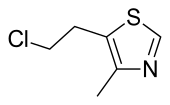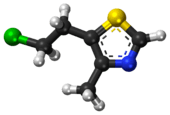Clomethiazole
Clomethiazole (also called chlormethiazole) is a sedative and hypnotic originally developed by Hoffmann-La Roche in the 1930s.[1] The drug is used in treating and preventing symptoms of acute alcohol withdrawal.
 | |
 | |
| Clinical data | |
|---|---|
| AHFS/Drugs.com | International Drug Names |
| Routes of administration | Oral |
| ATC code | |
| Legal status | |
| Legal status |
|
| Pharmacokinetic data | |
| Elimination half-life | 3.6–5 hours |
| Identifiers | |
| |
| CAS Number | |
| PubChem CID | |
| ChemSpider | |
| UNII | |
| KEGG | |
| ChEMBL | |
| CompTox Dashboard (EPA) | |
| ECHA InfoCard | 100.007.788 |
| Chemical and physical data | |
| Formula | C6H8ClNS |
| Molar mass | 161.65 g·mol−1 |
| 3D model (JSmol) | |
| |
| |
| | |
It is structurally related to thiamine (vitamin B1), but acts like a sedative, hypnotic, muscle relaxant and anticonvulsant, having the same mechanism of action as traditional barbiturates. It is also rarely used for the management of agitation, restlessness, short-term insomnia and Parkinson's disease in the elderly, when all other treatment options have failed. In the UK, it is sold under the brand Heminevrin (AstraZeneca Pharmaceuticals). Other brand names include Nevrin in Romania, Distraneurin in Germany and Distraneurine in Spain. The drug is marketed either as a free base in an oily solution containing 192 mg in capsule form, or as clomethiazole edisylate syrup. Due to its high toxicity compared to similar drugs it is not recommended as a first-line treatment for any indication and is particularly dangerous to patients with an elevated risk for drug abuse such as those with a personal or familial history of addiction.
Pharmacology
Clomethiazole acts as a positive allosteric modulator at the barbiturate/picrotoxin site of the GABAA receptor. It works to enhance the action of the neurotransmitter GABA at this receptor.[2] GABA is the major inhibitory neurotransmitter in the brain and produces anxiolytic, anticonvulsant, sedative, and hypnotic effects. Chlomethiazole appears to also have another mechanism of action mediating some of its hypothermic and neuroprotective effects.[2] The oxazole homologue is also known[3] providing a little QSAR information.
As opposed to barbiturates, clomethiazole doesn't affect the electrophysiological responses to excitatory aminoacids, and additionally, it also directly acts on chloride ion channels.
Clomethiazole is also a CYP2A6 and CYP2E1 enzyme inhibitor, and thus can affect the plasma clearance of substrates of those enzymes.
When clomethiazole is administered via IV in addition to carbamazepine, its clearance is increased by 30%, which results in a proportional reduction in plasma concentration. Therefore, when co-administered with carbamazepine or other potent CYP3A4 inducers via IV, it is necessary to increase the dose of clomethiazole.[4]
Adverse effects
Long term and frequent use of chlomethiazole can cause tolerance and physical dependence. Abrupt withdrawal may result in symptoms similar to those of sudden withdrawal of alcohol or benzodiazepines.[5]
Overdose
Clomethiazole is particularly toxic and dangerous in overdose and can be potentially fatal. Alcohol multiplies the effect. As the drug can be fatal in high doses, prescribing clomethiazole outside a controlled environment, like a hospital, is not recommended, especially because there are much less toxic alternatives, such as diazepam. Diazepam is one of many drugs belonging to the benzodiazepine class, with a long half-life (50–100 hours) and a very low risk of fatal overdose, as long as the patient does not consume alcohol or certain other types of medication.[6]
Due to clomethiazole's action at the barbiturate complex the benzodiazepine antidote flumazenil cannot reverse the effects of overdose; overdose treatment is restricted to the application of a mechanical ventilation apparatus until enough of the drug has been metabolized and/or excreted for the patient to breathe sufficiently without assistance. As with all GABAA agonists/allosteric agonists clomethiazole has a high potential for misuse and abuse, and intentional overdoses have been documented.
Drummer Keith Moon of the rock band The Who died of a clomethiazole overdose.[7]
See also
References
- CH patent 200248, "Verfahren zur Darstellung von 4-Methyl-5-B-chloräthylthiazol", issued 1938-09-30, assigned to Hoffmann-La Roche
- "Clomethiazole - an overview - ScienceDirect Topics". www.sciencedirect.com.
- US Patent 3401172 4-methyl-5-(beta-chloroethyl)oxazole
- Distraneurin 192mg: Summary of effects (In Croatian)
- Reilly TM (April 1976). "Physiological dependence on, and symptoms of withdrawal from, chlormethiazole". The British Journal of Psychiatry. 128 (4): 375–8. doi:10.1192/bjp.128.4.375. PMID 1260235.
- Reith DM, Fountain J, McDowell R, Tilyard M (2003). "Comparison of the fatal toxicity index of zopiclone with benzodiazepines". Journal of Toxicology. Clinical Toxicology. 41 (7): 975–80. doi:10.1081/CLT-120026520. PMID 14705844.
- Springer M (2013-05-20). "Keith Moon's Last Interview, 1978". Retrieved 2014-10-11.
An autopsy showed that Moon had taken 32 tablets of clomethiazole. His doctor had told him not to exceed three per day.